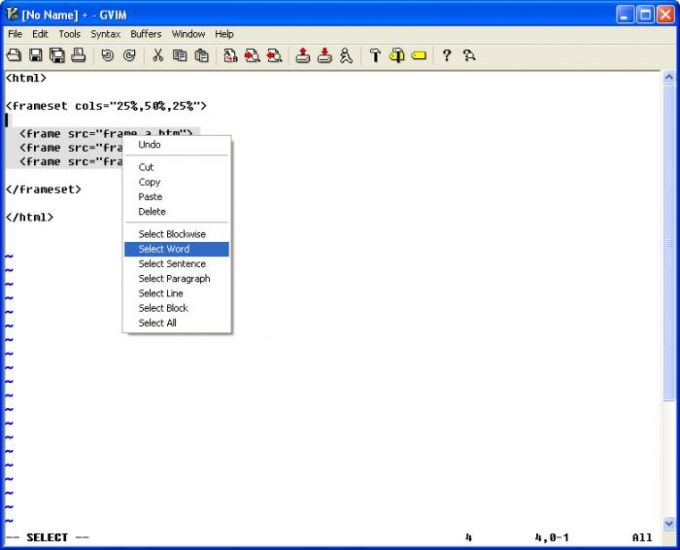Gvim For Mac
MacVim is more integrated in the whole OS than Vim in the Terminal or even GVim in Linux, it follows a lot of Mac OS X's conventions. If you work mainly with GUI apps (YummyFTP + GitX + Charles, for example) you may prefer MacVim. If you work mainly with CLI apps (ssh + svn + tcpdump, for example) you may prefer vim in the terminal. I'm running gvim on my mac from /usr/local/bin. If I invoke it from a terminal window it opens it up in a new window. I'd like to get it to just run in the same window I'm already using. The vimrc file is located in your home directory, so on Mac, Unix, and Linux systems the vimrc file actually begins with a decimal (it’s a “hidden” file), so you can edit it like this: vi /.vimrc I haven’t used Windows in a long time, but I think the filename is just vimrc on Windows’ systems.
MacVim 采用了分离进程的方式,一个 MacVim 程序可以启动多个 vim 进程,每个显示在一个 MacVim 窗口中,这是官方的 vim 和其他平台下的 gvim 所不支持的。MacVim 还支持很多 Mac OS X 原生的界面特性,比如工具栏、滚动条、全屏显示、Mac 菜单快捷键的绑定等。. Note: If you’re decent at Vim and want your mind blown, check out Advanced Vim. I’ve compiled a list of essential Vim commands that I use every day. I have then given a few instructions on how to make Vim as great as it should be, because it’s painful without configuration. Vim for Mac is an advanced text editor, which harvests the power of Unix' editor 'Vi', albeit with an enhanced feature set. It is highly configurable, and has been designed to enable efficient text editing, much like 'Vi' Key features include: Vim offers syntax highlighting for over 200 languages. Highlighting Matches. Setting a default gvim color scheme (colorscheme) As a friend of mine once, said “It’s easy to do, once you know how to do it.” For me, that applies to setting a default colorscheme for gvim on Mac OS X. To set your vim default colorscheme to a theme named “slate,” just follow these steps: 1) First, edit a file named /.gvimrc. If it doesn’t already exist, create it.
Vi is an one of two powerhouse text editors in the Unix world, the other being EMACS. While obtuse, vi is extremely powerful and efficient. There may be times when vi is the only text editor available, so it helps to at least know the basics.On Mac OS X (and Linux), vi is symlinked to vim (vi improved), a more modern free software version. Vim It is the default editor when changing a crontab.
If you gave vi a whirl and don't see the beauty of it, give the nano editor a try. It also ships with Mac OS X.
note: a chunk of this small guide came from a web page I found long ago, but I don't remember where so I can't give proper credit. I've added and changed things from the original text.
Vi has two modes, command and insert (really, three if you count replace mode). Command mode is used to navigate, search, and issue other commands. Insert mode is used to enter text.
Vi starts in command mode.
You can precede most commands with a number indicating how many times to perform a command. For example, entering 99 followed by the down arrow will move the cursor down 99 lines. '99x' will delete 99 characters.
Download Mozilla Firefox for Mac, a free Web browser. Firefox is created by a global non-profit dedicated to putting individuals in control online. Get Firefox for Mac today! Click the menu button, click Help and select About Firefox. On the menu bar click the Firefox menu and select About Firefox. The About Mozilla Firefox About Firefox window will open. Firefox will begin checking for updates and downloading them automatically. Download Mozilla Firefox, a free Web browser. Firefox is created by a global non-profit dedicated to putting individuals in control online. Get Firefox for Windows, macOS, Linux, Android and iOS today! Firefox update for mac. Installing Firefox on Mac Visit the Firefox download page in any browser (for example, Apple Safari). It will automatically detect the platform and language on your computer and recommend the best version of Firefox for you. Click the green download button to download Firefox.
Gvim For Mac Download
While in command mode (case sensitive)Vim App For Mac

- move the cursor with arrow keys; if there aren't any arrow keys, use j,k,h,l
- i - change to insert mode (before cursor)
- a - change to insert mode (after cursor)
- A - change to insert mode (at end of line)
- r - replace one character
- R - overwrite text
- x - delete one character
- dd - delete one line
- yy - yank line (copy)
- p - paste deleted or yanked text after cursor
- P - paste deleted or yanked text before cursor
- G - go to end of the file
- 1G - go to top of the file
- J - merge next line with this one
- / - search, follow / with text to find
- :wq - write file and quit
- :q! - quit without saving
- %s/old/new/g - substitute; replace 'old' with 'new' on all lines
- :g/pattern/d - delete all lines that match the pattern
Vim Macro
- ESC - change to command mode
- any text typed is entered at the cursor
Gvim For Mac Osx
- Type 'vi file.txt' at command prompt
- Move cursor to where new text will be added
- Type 'i' to change to insert mode
- Type new text
- Type ESC to go back to command mode
- type ':wq' and ENTER to write the file and quit